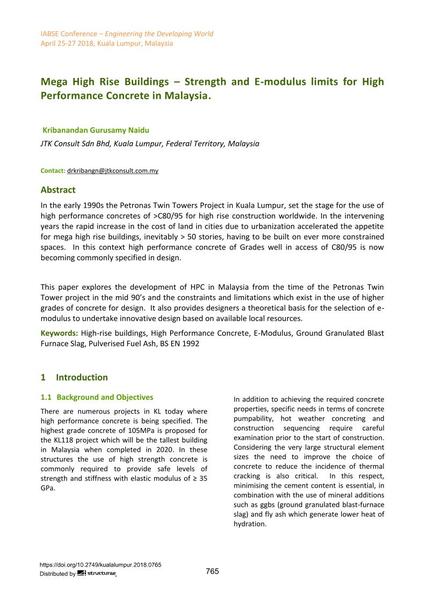Mega High Rise Buildings – Strength and E-modulus limits for High Performance Concrete in Malaysia.

|
|
|||||||||||
Bibliografische Angaben
| Autor(en): |
Kribanandan Gurusamy Naidu
(JTK Consult Sdn Bhd, Kuala Lumpur, Federal Territory, Malaysia)
|
||||
|---|---|---|---|---|---|
| Medium: | Tagungsbeitrag | ||||
| Sprache(n): | Englisch | ||||
| Tagung: | IABSE Conference: Engineering the Developing World, Kuala Lumpur, Malaysia, 25-27 April 2018 | ||||
| Veröffentlicht in: | IABSE Conference Kuala Lumpur 2018 | ||||
|
|||||
| Seite(n): | 765-772 | ||||
| Anzahl der Seiten (im PDF): | 8 | ||||
| DOI: | 10.2749/kualalumpur.2018.0765 | ||||
| Abstrakt: |
In the early 1990s the Petronas Twin Towers Project in Kuala Lumpur, set the stage for the use of high performance concretes of >C80/95 for high rise construction worldwide. In the intervening years the rapid increase in the cost of land in cities due to urbanization accelerated the appetite for mega high rise buildings, inevitably > 50 stories, having to be built on ever more constrained spaces. In this context high performance concrete of Grades well in access of C80/95 is now becoming commonly specified in design. This paper explores the development of HPC in Malaysia from the time of the Petronas Twin Tower project in the mid 90’s and the constraints and limitations which exist in the use of higher grades of concrete for design. It also provides designers a theoretical basis for the selection of e- modulus to undertake innovative design based on available local resources. |
||||
| Stichwörter: |
Hochhäuser
|
||||
